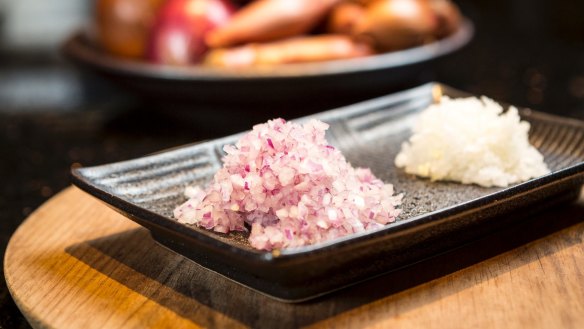How to stop the tears when cutting onions

How do I stop crying when chopping onions? S. Freeman
Apart from the former Member for Warringah, I don't think any human alive is immune to onions' powerful sulphur-based defence system. Onions accumulate sulphur from the soil in their cells. When you start chopping an onion, it thinks it is coming under attack. Enzymes catalyse a reaction that helps form lachrymators, compounds that attack nerves in our nose and eyes, causing tears. There are many supposed remedies. Some work, others don't. Holding a teaspoon between your teeth doesn't stop the waterworks. Nor does leaving the root end intact while chopping the onion. Chilling an onion does slow down the enzymatic effect, resulting in fewer tears. Chopping onions under running water does wash away the irritants but, dangerously, increases your chances of slipping and running the knife through your finger. Using a very sharp knife to chop onions does help, too. My youngest daughter taught this old dog new tricks recently when she started slicing onions while wearing her swimming goggles. There were no tears, just a sticky film on the outside of the goggles where the tinted plastic had stopped the onion's defence system from getting into her eyes.
If there was one herb you would plant in your garden, what would it be? S. Perrot
Many years ago, I arrived in London just before a very cold Christmas. After a summer hitchhiking around Europe, I was tired and poor. Staying at a friend's place in Pimlico, I walked around London as the snow began to fall. A keen gardener, I noticed two plants predominant in the front gardens. They were Aucuba japonica or gold laurel, and Laurus nobilis or bay tree. Both are genuinely hardy plants able to cope with the pollution of London's streets. The former, however, is poisonous; the latter is one of the most wonderful culinary herbs. Hold a bay leaf up to the light, and you will see a polka dot pattern of little cauldrons filled with essential oils. When you drop a leaf or two into a stew, the oils are released, infusing the dish with the fresh and resinous perfume, while alluding to darker, deeper aromas. This note can act as the thread that ties together discordant flavours to make the dish greater than the sum of its parts. Slide a single bay leaf into ratatouille, and its slightly darker notes subdue the ebullient nature of summer vegetables. Bay brings forward the savoury element in slow-cooked meat dishes and works wonderfully with nutmeg with braises of neck, shoulder and leg cuts. Bay and juniper are classic seasonings for game, particularly if it has been hung, the bay accentuating the flesh's decadence. For a savoury bread-and-butter pudding, simmer onions and bay leaves in milk, let it cool, whisk through some eggs and pour over a dish of buttered slices of sourdough and bake until set. A bay tree can grow to spread over a backyard, but when kept trimmed, can form an evergreen hedge, an ornamental specimen or can be grown in a pot. They grow as well in Hobart as Humpty Doo. For the record, that Christmas I cooked lunch and used some bay leaves filched from a private garden to season the cooking juices of the turkey to make gravy.
Send your vexing culinary conundrums to brainfood@richardcornish.com.au or tweet to @foodcornish
Appears in these collections
- More:
- Food
- Brain food
